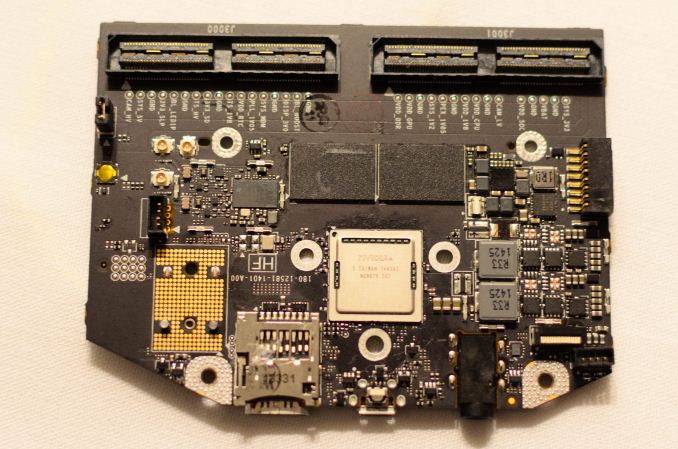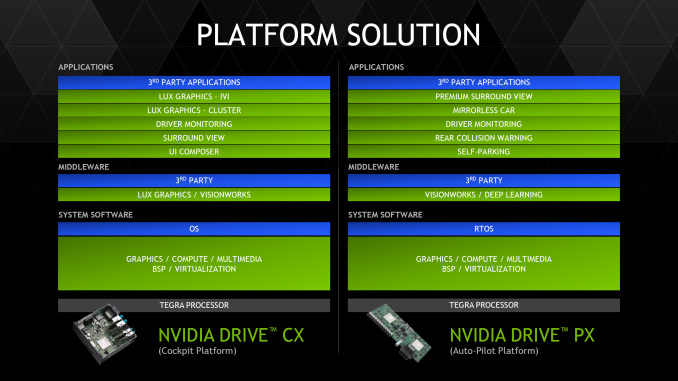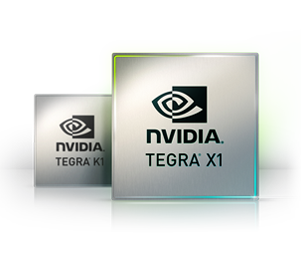NVIDIA Tegra X1 Preview & Architecture Analysis
by Joshua Ho & Ryan Smith on January 5, 2015 1:00 AM EST- Posted in
- SoCs
- Arm
- Project Denver
- Mobile
- 20nm
- GPUs
- Tablets
- NVIDIA
- Cortex A57
- Tegra X1
Final Words
With the Tegra X1, there have been a great deal of changes when compared to Tegra K1. We see a move from Cortex A15 to A57 on the main cluster, and a move from a single low power Cortex A15 to four Cortex A53s which is a significant departure from previous Tegra SoCs. However, the CPU design remains distinct from what we see in SoCs like the Exynos 5433, as NVIDIA uses a custom CPU interconnect and cluster migration instead of ARM’s CCI-400 and global task scheduling. Outside of these CPU changes, NVIDIA has done a great deal of work on the uncore, with a much faster ISP and support for new codecs at high resolution and frame rate, along with an improved memory interface and improved display output.
Outside of CPU, the GPU is a massive improvement with the move to Maxwell. The addition of double-speed FP16 support for the Tegra X1 helps to improve performance and power efficiency in applications that will utilize FP16, and in general the mobile-first focus on the architecture makes for a 2x improvement in performance per watt. While Tegra K1 set a new bar for mobile graphics for other SoC designers to target, Tegra X1 manages to raise the bar again in a big way. Given the standards support of Tegra X1, it wouldn’t be a far leap to see more extensive porting of games to a version of SHIELD Tablet with Tegra X1.
NVIDIA has also made automotive applications a huge focus in Tegra X1 in the form of DRIVE CX, a cockpit computing platform, and DRIVE PX, an autopilot platform. Given the level of integration and compute present in both DRIVE CX and PX, there seems to be a significant amount of value in NVIDIA’s solutions. However, it remains to be seen whether OEMs will widely adopt these solutions as car manufacturers can take multiple years to implement a new SoC. Compared to the 3-4 month adoption rate of an SoC in a phone or tablet, it's hard to pass any judgment on whether or not NVIDIA's automotive endeavors will be a success.
Overall, Tegra X1 represents a solid improvement over Tegra K1, and now that NVIDIA has shifted their GPU architectures to be targeted at mobile first, we’re seeing the benefits that come with such a strategy. It seems obvious that this would be a great SoC to put in a gaming tablet and a variety of other mobile devices, but it remains to be seen whether NVIDIA can get the design wins necessary to make this happen. Given that all of the high-end SoCs in the Android space will be shipping with A57 and A53 CPUs, the high-end SoC space will see significant competition once again.













194 Comments
View All Comments
chizow - Monday, January 5, 2015 - link
Careful, you do mean A8X right? Because Denver K1 is an actual product that absolutely stomps A8, only after Apple somewhat unexpectedly "EnBiggened" their A8 by increasing transistors and functional units 50%, did they manage to match K1's GPU and edge the CPU in multi-core (by adding a 3rd core).To say Denver K1 didn't deliver is a bit of a joke, since it is miles ahead of anything on the Android SoC front, and only marginally bested in CPU due to Apple's brute-force approach with A8X while leveraging 20nm early. We see that once the playing field has been leveled 20nm, its no contest in favor of Tegra X1.
Jumangi - Monday, January 5, 2015 - link
I mean a product that is widely available to CONSUMERS dude. And please stop with the "stomping" stuff. It means nothing about its performance with its also vastly higher power consumption. The A8 can exist in a smartphone. What smartphones have the K1? Oh that's right none because you would get a hour of use before your battery was dead. Mobile is about performance and speed. You can diss Apple all you want but from an SoC perspective they do it better than anyone else right now.pSupaNova - Tuesday, January 6, 2015 - link
@Jumangi try to comprehend what he is saying.Apple used a superior process on its A8X and more transistors to just edge the K1 in some CPU benchmarks. While core for core Nvida's is actually more powerful.
The GPU in the K1 also has near desktop parity etc OpenGL 4.4. Features like Hardware Tessellation are absent from the A8X.
Alexey291 - Tuesday, January 13, 2015 - link
That's great. It really is but lets be honest. A8x is faster than K1.And end of the day that is sadly all that matters to the vaaaaaast majority of consumers.
Frankly even that barely matters. What does though is that games run better on my tablet than they do on yours so to speak. (Actually likely they run better on yours since I'm still using a nexus 10 xD)
But sure the new paper launch from nv late this year our early next year will be great and the 2.5 devices that x1 will appear in will be amazing. Making sales in hundreds of thousands.
SM123456 - Sunday, February 1, 2015 - link
The point is that the Tegra K1 Denver on 28nm beats the Apple A8 fairly comprehensively on 20nm with the same number of cores. Apple stuck on 50% more cores and 50% more transistors to allow the A8X on 20nm to have a slight edge over the Tegra K1 Denver. This means if Tegra K1 is put on 20nm, it will beat the 3 core Apple A8X with two cores, and the same thing will happen when both move to 16nm.utferris - Monday, April 13, 2015 - link
Oh. Really? Denver K1 is not even as fast as A8X. Do not mention that it uses more than 2 times energy. I really do not understand people like you going around and saying how good nvidia shit is.eanazag - Wednesday, January 7, 2015 - link
It'll likely be in the next Shield.name99 - Monday, January 5, 2015 - link
(1) I wouldn't rave too enthusiastically about Denver. You'll notice nV didn't...Regardless of WHY Denver isn't on this core, the fact that it isn't is not a good sign. Spin it however you like, but it shows SOMETHING problematic. Maybe Denver is too complicated to shift processes easily? Maybe it burns too much power? Maybe it just doesn't perform as well as ARM in the real world (as opposed to carefully chosen benchmarks)?
(2) No-one gives a damn about "how many GPU cores" a SoC contains, given that "GPU core" is a basically meaningless concept that every vendor defines differently. The numbers that actually matter are things like performance and performance/watt.
(3) You do realize you're comparing a core that isn't yet shipping with one that's been shipping for three months? By the time X1 actually does ship, that gap will be anything from six to nine months. Hell, Apple probably have the A9/A9X in production TODAY at the same level of qualification as X1 --- they need a LONG manufacturing lead time to build up the volumes for those massive iPhone launches. You could argue that this doesn't matter since the chip won't be released until September except that it is quite likely that the iPad Pro will be launched towards the end of Q1, and quite likely that it will be launched with an A9X, even before any Tegra X1 product ships.
chizow - Tuesday, January 6, 2015 - link
@Name991) Huh? Denver is still one of Nvidia's crowning achievements and the results speak for themselves, fastest single-core ARM performance on the planet, even faster than Apple's lauded Cyclone. Why it isn't in this chip has already been covered, its a time to market issue. Same reason Nvidia released a 32-bit ARM early and 64-bit Denver version of Tegra K1 late, time to market. Maybe, in the tight 6 month window they would have needed between bringing Denver and working on Erista, they simply didn't have enough time for another custom SoC? I'm not even an Apple fan and I was impressed with Cyclone when it was first launched. But suddenly, fastest single-core and a dual-core outperforming 4 and even 8-core SoC CPUs is no longer an impressive feat! That's interesting!
2) Actually, anyone who is truly interested does care, because on paper, a 6-core Rogue XT was supposed to match the Tegra K1 in theoretical FLOPs performance. And everyone just assumed that's what the A8X was when Apple released the updated SoC that matched TK1 GPU performance. The fact it took Apple a custom 8-core variant is actually interesting, because it shows Rogue is not as efficient as claimed, or conversely, Tegra K1 was more efficient (not as likely since real world synthetics match their claimed FLOPs counts). So if 6 core was supposed to match Tegra K1 but it took 8 cores, Rogue XT is 33% less efficient than claimed.
3) And you do realize, only a simpleton would expect Nvidia to release a processor at the same performance level while claiming a nearly 2x increase in perf/w right? There's live demos and benchmarks of their new X1 SoC for anyone at CES to test, but I am sure the same naysayers will claim the same as they did for the Tegra K1 a year ago, saying it would never fit into a tablet, it would never be as fast as claimed yada yada yada.
Again, the A9/A9X may be ready later this year, but the X1 is just leveling the playing field at 20nm, and against the 20nm A8/X we see it is no contest. What trick is Apple going to pull out of its hat for A9/A9X since they can't play the 20nm card again? 16nm FinFET? Possible, but that doesn't change the fact Apple has to stay a half step ahead just to remain even with Nvidia in terms of performance.
lucam - Wednesday, January 7, 2015 - link
1) He was saying: why NV didn't continue with Denver design? Being so efficient and only 2 cores why don't shift at 20nn easily? Because they can't and that's it. The other things are speculations.2) You still compare apple (not Apple) with pears. Any vendors put inside his proprietary technology with their market strategy, important is to figure how GFLOPS and Texel is capable at same frequency and watt. You don't even know how Img cluster is built and nobody does and you still compare with NV cuda cores. Rogue XT frequency is set at 200mhz, Tegra K1 at 950mhz. Again what the heck you re talking about.
3) it is still a prototype type with a fan and nobody could check all the real frequency even though 1ghz seem reasonable. Hod dare you can compare a tablet with a reference board?
Again A9/A9X already exist now as prototypes, Apple doesn't sell chips and doesn't to any those sort of market. They need to see their product in a cycle year life. You live in another planet to not understand that.